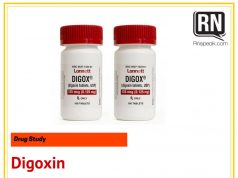Generic Name: Ibuprofen
Brandname: Advil, Amersol , Children’s Motrin, Haltran, Ibuprin, Junior Strength Motrin Caplets, Medipren, Motrin, Nuprin, Pediaprofen, Pamprin-IB, Rufen, Trendar
Classifications: central nervous system agent; nsaid (cox-1); analgesic; antipyretic
Pregnancy Category:B
Availability:
100 mg, 200 mg, 400 mg, 600 mg, 800 mg tablets; 50 mg, 100 mg chewable tablest; 100 mg/5 mL, 100 mg/2.5 mL suspension; 40 mg/mL drops
Actions:
Prototype of the propionic acid NSAIDs (cox-1) inhibitor with nonsteroidal antiinflammatory activity and significant antipyretic and analgesic properties. Blocks prostaglandin synthesis. Ibuprofen activity also includes modulation of T-cell function, inhibition of inflammatory cell chemotaxis, decreased release of superoxide radicals, or increased scavenging of these compounds at inflammatory sites.
Route & Dosage
adult: PO 400–800 mg t.i.d. or q.i.d. (max: 3200 mg/d)
child: PO < 20 kg, up to 400 mg/d in divided doses; 20–30 kg, up to 600 mg/d in divided doses; 30–40 kg, up to 800 mg/d in divided doses
Mild to Moderate Pain, Dysmenorrhea
adult: PO 400 mg q4–6h up to 1200 mg/d
adult: PO 200–400 mg t.i.d. or q.i.d. (max: 1200 mg/d)
child: PO 6 mo–12 y, 5–10 mg/kg q4–6h up to 40 mg/kg/d
Oral
- Give on an empty stomach, 1 h before or 2 h after meals. May be taken with meals or milk if GI intolerance occurs.
- Ensure that chewable tablets are chewed or crushed before being swallowed.
- Note: Tablet may be crushed if patient is unable to swallow it whole and mixed with food or liquid before swallowing.
- Store in tightly closed, light-resistant container unless otherwise directed by manufacturer.
Adverse effects
CV:Hypertension, palpitation, congestive heart failure (patient with marginal cardiac function); peripheral edema.
SpecSenses:Amblyopia (blurred vision, decreased visual acuity, scotomas, changes in color vision); nystagmus, visual-field defects; tinnitus, impaired hearing.
Nursing Implication
Assessment & Drug Effects
- Monitor for therapeutic effectiveness. Optimum response generally occurs within 2 wk (e.g., relief of pain, stiffness, or swelling; or improved joint flexion and strength).
- Observe patients with history of cardiac decompensation closely for evidence of fluid retention and edema.
- Lab tests: Baseline and periodic evaluations of Hgb, renal and hepatic function, and auditory and ophthalmologic examinations are recommended in patients receiving prolonged or high-dose therapy.
- Monitor for GI distress and S&S of GI bleeding.
- Note: Symptoms of acute toxicity in children include apnea, cyanosis, response only to painful stimuli, dizziness, and nystagmus.
Patient & Family Education
- Notify physician immediately of passage of dark tarry stools, “coffee ground” emesis, frankly bloody emesis, or other GI distress, as well as blood or protein in urine, and onset of skin rash, pruritus, jaundice.
- Do not drive or engage in other potentially hazardous activities until response to the drug is known.
- Do not self-medicate with ibuprofen if taking prescribed drugs or being treated for a serious condition without consulting physician.
- Do not take aspirin concurrently with ibuprofen.
- Avoid alcohol and NSAIDs unless otherwise advised by physician. Concurrent use may increase risk of GI ulceration and bleeding tendencies.
- Do not breast feed while taking this drug without consulting physician.








I take analgesics whenever i have fever. Paracetamol is still one of the safest analgesics ever. ”